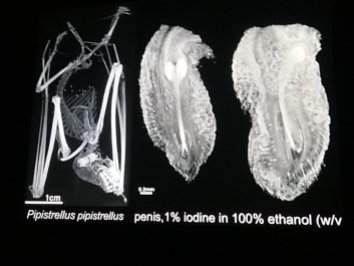
Diffusible iodine-based contrast-enhanced computed tomography (diceCT) and related imaging techniques for research in evolutionary morphology
Organizers: P. M. Gignac1*, A. N. Herdina2, N. J. Kley3, A. Morhardt4, J. A. Clarke5, and M. Colbert5
The ability to visualize hard tissues (e.g., bone, dentine, enamel) rapidly in three dimensions using X-ray computed tomography (CT) has been one of the most important advancements in the field of vertebrate morphology in the last half-century. Until recently, however, comparably valuable advances in soft-tissue imaging have been difficult to realize fully due to the inherently low X-ray absorption of non-mineralized structures. Pioneering work in this area has demonstrated that Lugol’s iodine (I2KI) is a highly effective contrast agent for rapidly differentiating many types of soft tissues (e.g., epithelial, muscular, and neural structures) in micro computed tomography (μCT) images. Vertebrate morphologists have become a driving force in advancing this technique and utilizing the remarkable data generated from it to reconstruct phenotypes and functional anatomy in three and four dimensions.

Given the broad potential for iodine-enhanced CT imaging to become a major tool for soft-tissue reconstruction in vertebrate morphology, we will hold a symposium at the 2016 ICVM meeting to exhibit the wide range of taxa and questions that can be examined using these approaches. Through our symposium, Diffusible iodine-based contrast-enhanced computed tomography (diceCT) and related imaging techniques for research in evolutionary morphology, we featured the newest and ongoing applications of contrast-enhanced three-dimensional (3-D) imaging already being undertaken by researchers within the International Society of Vertebrate Morphology. Our goals were to spur the further adoption of these methods by vertebrate morphologists by (1) highlighting recent methodological advances in contrast-enhanced CT and μCT imaging, (2) demonstrating active research that integrates diceCT and related imaging techniques into toolkits addressing macroevolutionary questions, and (3) generating discussions of future directions and the long-term place for contrast-enhanced imaging in the study of extant vertebrates. Our diverse group of speakers included well-established researchers, emerging early-career scientists, and graduate students in the fields of functional morphology, biomechanics, phenotypic integration, and vertebrate paleontology, whose academic contributions have already brought important insights to evolutionary biology. Our hope is that demonstration of the high-level inferences that can be garnered with diceCT will spur collaborations among labs already exploring this powerful new tool with those who are considering how to apply it to their own research questions.
ICVM-11 Abstracts Available here.
Poster Symposium
- Green — Physiological examination of ratite orthopedic disorders and soft- tissue visualization via micro-CT
- Herrel — Contrast-enhanced versus phase-contrast imaging: costs and benefits of different methods
- Holliday — DiceCT and its applications for understanding the reptile musculoskeletal system [e.g., Alligator mississippiensis]
Introduction & Neurological Visualization
- Watanabe — Mind the Gap: ontogenetic shape differences between brains and endocasts in archosaurs
Functional Morphology
- Charles — Musculoskeletal modelling and simulations of the mouse hind limb during locomotion: the role of high-resolution scanning and contrast Imaging (15 min)
- Lautenschlager — The evolution of the mammalian jaw adductor musculature – inferences from soft-tissue imaging of extant taxa [extension of techniques from Lautenschlager et al., 2013]
- Orsbon— Integration of diceCT with XROMM and fluoromicrometry enhances functional morphology and biomechanics research: a case study of the macaque (Mammalia: Primates) feeding apparatus
Descriptive Anatomy
- Pardo —Studying metamorphosis of the cranial musculoskeletal system in the axolotl using contrast-μCT
- Porro —Contrast-enhanced micro-CT imaging of fish and frogs: digital dissections and biomechanical applications
- Yohe —The curious case of the vomeronasal organ in bats: genetics asks questions only anatomy can answer
- Vander Linden —Comparative morphology of bat cranial muscles using contrast enhanced micro-CT imaging
Advancements and Infrastructure for Contrast-enhanced Imaging Techniques
- Mahlow — DiceCT and the staining of old museum specimens, exemplified by the analysis of venom glands in viperid snakes
- Starck —The publishing and archiving of microscopic anatomy
1*Department of Anatomy and Cell Biology, Oklahoma State University Center for Health Sciences, Tulsa, OK, USA (corresponding organizer: paul.gignac@okstate.edu)
2Department of Theoretical Biology, University of Vienna, Vienna, Austria
3Department of Anatomical Sciences, Stony Brook University School of Medicine, Stony Brook, NY, USA
4Department of Neuroscience, Washington University in St. Louis School of Medicine, St. Louis, MO, USA
5Jackson School of Geosciences, The University of Texas at Austin, Austin, TX, USA

















